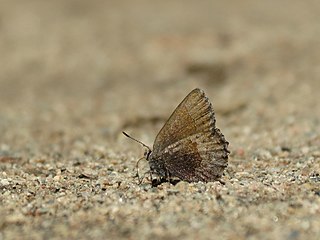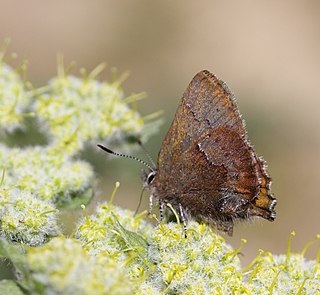
Cercis canadensis, the eastern redbud, is a large deciduous shrub or small tree, native to eastern North America from southern Michigan south to central Mexico, west to New Mexico. Species thrive as far west as California and as far north as southern Ontario. It is the state tree of Oklahoma. The prevalence of the so-called "Columbus strain" has seen the residents of Columbus, Wisconsin embrace the plant into their city's identity. Known as the "Redbud City," the town hosts "Redbud Day" annually the Saturday before Mother's Day, organizing a variety of themed events to recognize the tree.

Ilex opaca, the American holly, is a species of holly, native to the eastern and south-central United States, from coastal Massachusetts south to central Florida, and west to southeastern Missouri and eastern Texas.

The great purple hairstreak, also called the great blue hairstreak, is a common gossamer-winged butterfly species in parts of the United States. It is actually a Neotropical species; its North American range only includes the warm-temperate and subtropical parts of that continent, and it ranges southwards almost to the Isthmus of Panama. The type specimen, however, was shipped to Europe from the Colony of Virginia, probably around the time of the United States Declaration of Independence.

The green hairstreak is a small butterfly in the family Lycaenidae.

The holly blue is a butterfly that belongs to the lycaenids or blues family and is native to the Palearctic.

The Zabulon skipper is a North American butterfly first described by the French naturalists Jean Baptiste Boisduval and John Eatton Le Conte from the state of Georgia, United States.

The genus Callophrys consists of butterflies in the family Lycaenidae. It is apparently not monophyletic, but which of the taxa currently considered junior synonyms of Callophrys are valid genera remains to be determined.

Callophrys gryneus, the juniper hairstreak or olive hairstreak, is a butterfly native to North America. It belongs in the family Lycaenidae.

Polites themistocles, the tawny-edged skipper, is a North American butterfly in the family Hesperiidae.

Callophrys irus, the frosted elfin, is a species of Lycaenidae that is native to North America.

Chlorostrymon simaethis, the silver-banded hairstreak, is a North and South American butterfly in the family Lycaenidae. It is also known as St. Christopher's hairstreak and the Key lime hairstreak.

Callophrys augustinus, the brown elfin, is butterfly of the family Lycaenidae. It is found from Newfoundland north and west through the northern United States and the prairie provinces to Alaska. To the south it ranges in Appalachian Mountains to northern Georgia and northern Alabama, further south through the western mountains to northern Baja California in Mexico. Subspecies iroides is known as the western elfin.

Callophrys polios, the hoary elfin, is a butterfly of the family Lycaenidae. It has a very local distribution in the United States from Maine south to New Jersey and in the Appalachian Mountains to Virginia, west across the Great Lakes states and the southern prairie provinces and north to Alaska. Along the Pacific Coast it is found to northern California and in the Rocky Mountains south to northern New Mexico. It is listed as a species of special concern and believed extirpated in the US state of Connecticut.

Callophrys mossii, commonly known as Moss's elfin, stonecrop elfin or Schryver's elfin, is a species of butterfly native to North America in the family Lycaenidae. It is found from British Columbia south to southern California and east to Wyoming and Colorado in isolated populations. The habitat consists of rocky outcrops, woody canyons and cliffs.
Callophrys fotis is a species of butterfly in the family Lycaenidae, the gossamer-winged butterflies. It is known by several common names, including early elfin, desert elfin, Fotis hairstreak, Strecker's elfin, and Arizona gray elfin. It is native to the southwestern United States, where it occurs in southeastern California, Nevada, Utah, western Colorado, northern Arizona, and northwestern New Mexico.

Satyrium liparops, the striped hairstreak, is a butterfly of the family Lycaenidae described by John Eatton Le Conte in 1833. It is found in North America, from the Rocky Mountains south from southern Canada to Colorado, east to Maine and south to Florida.

Callophrys xami, commonly referred to as the xami hairstreak or green hairstreak, is a butterfly included in the subgenus Xamia and the genus Callophrys in the family Lycaenidae. It was described by Tryon Reakirt in 1867. Other common names for this species, depending on the region, include green hairstreak and elfin. C. xami is considered to be a very rare species of butterfly, and its typical range is in southern Arizona and Texas including down south to Guatemala. The juniper hairstreak and the silver-banded hairstreak butterflies are similar species, but both differ significantly from C. xami in regards to the postmedian white line running across the butterfly wings.



















